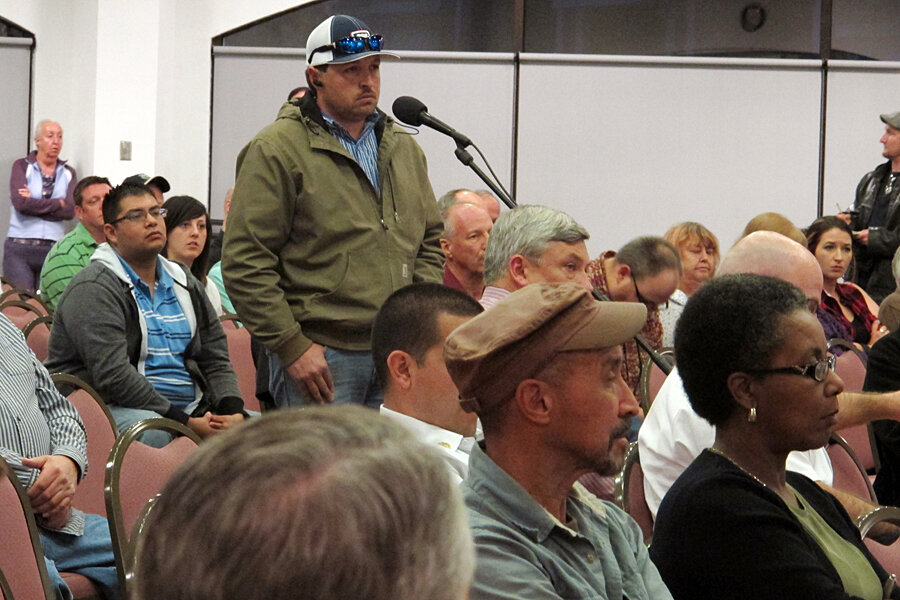Radiation leak in N.M. exposes 13 workers: what's known so far
Loading...
The US Department of Energy is investigating a mid-February release of radioactivity from an underground nuclear-waste storage site in southeastern New Mexico.
No one was in the underground storage site when the leak was detected late Feb. 14, according to officials at the site. But tests have identified 13 workers who were working above ground that night and were contaminated after inhaling some of the radioactive particles that were released.
Additional tests are under way to determine the level of contamination they have experienced, even as officials are fielding requests from other workers to be tested.
The leak was a dubious first for the Energy Department's Waste Isolation Pilot Plant near Carlsbad, N.M. The facility receives transuranic waste – waste contaminated by radioactive elements with half-lives of 20 years or more – from national laboratories, in particular those involved with nuclear weapons and research into nuclear energy. The waste – tools, clothing, plastic packaging, and other contaminated materials – are kept in specially designed 55-gallon drums.
Investigators have actually been on-site since early February, initially investigating a fire involving a truck that hauls salt, according to Deb Gill, spokeswoman for the DOE plant. Once the leak was detected, the investigation team was reassigned and augmented with additional nuclear experts, she writes in an e-mail.
The storage facility itself is located 2,150 feet below the surface. The storage area is divided into eight side shafts, or panels, each with six "rooms" the size of football fields. The panels are excavated from a vast salt deposit some 3,000 feet thick. As each panel is filled, it's sealed. The salt's natural tendency to deform eventually encases the waste drums in a solid salt sarcophagus.
The facility currently holds some 91,000 cubic meters of waste in seven rooms. The leak appears to have originated in Panel 7, which has just under 400 cubic meters of waste in it.
Gauging the severity of the event at this stage is difficult. The open-air releases reportedly have been small, and the data from monitoring devices in Panel 7 suggest the amount of radioactivity has fallen a thousandfold since the leak was first detected, plant officials have said.
But the DOE has taken more measurements than it has released so far, cautions Don Hancock, director of the Southwest Research and Information Center's nuclear-waste safety program. And another monitoring agency, the Carlsbad Environmental Monitoring & Research Center, had been good about releasing its data, "but it has a lot more sampling and analysis that's still in process," Mr. Hancock says.
Given public concerns about the leak, Sens. Tom Udall (D) and Martin Heinrich (D) of New Mexico sent a letter to US Environmental Protection Agency Administrator Gina McCarthy on Thursday asking the agency to undertake independent tests for radioactivity and explain how the release stacks up against agency standards.
As for longer-term consequences, "it's hard to say how serious this is until they get to the root cause of the leak," agrees Edwin Lyman, a physicist and senior scientist for the Union of Concerned Scientists' global security program.
He offers one possible cause: A chunk of ceiling could have landed on one or more drums, rupturing them. Depending on the nature of the waste in the drums, radioactivity's reaction with plastics could have generated hydrogen gas. The drums are designed to accommodate such a buildup, he says. But such reactions could have increased the pressure in a drum sufficiently to trigger a rupture if the drum was struck by a chunk of ceiling.
Also, it's unclear what impact the facility's outage will have on operations at the national laboratories generating the waste.
Officials have suggested that it could be another two or three weeks before they send probes down a salt-handling shaft to provide an initial read on how safe it may be to send people back in, according to Hancock.
Once it's deemed safe enough to send people back underground to determine the cause, they next need to come up with a recovery plan, Ms. Gill of the DOE explains.
Then comes the task of decontamination of surfaces, especially in work areas – a process whose pace is determined by the extent of contamination, Dr. Lyman says.
If the underlying cause of the leak is a random, one-off event, it would be relatively easy to come up with a repair strategy and continue with operations, he continues. But if the event reveals flaws in the analyses that served as the foundation for the site's approval, such flaws could be more challenging and time-consuming to deal with.






